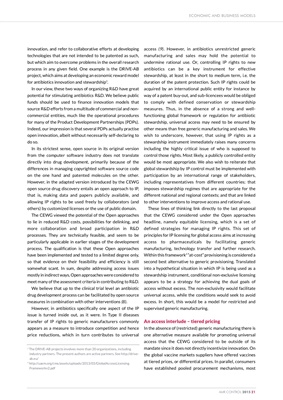
innovation, and refer to collaborative efforts at developing
technologies that are not intended to be patented as such,
but which aim to overcome problems in the overall research
process in any given field. One example is the DRIVE-AB
project, which aims at developing an economic reward model
for antibiotics innovation and stewardship3.
In our view, these two ways of organizing R&D have great
potential for stimulating antibiotics R&D. We believe public
funds should be used to finance innovation models that
source R&D efforts from a multitude of commercial and noncommercial
entities, much like the operational procedures
for many of the Product Development Partnerships (PDPs).
Indeed, our impression is that several PDPs actually practise
open innovation, albeit without necessarily self-declaring to
do so.
In its strictest sense, open source in its original version
from the computer software industry does not translate
directly into drug development, primarily because of the
differences in managing copyrighted software source code
on the one hand and patented molecules on the other.
However, in the adapted version introduced by the CEWG
open source drug discovery entails an open approach to IP,
that is, making data and papers publicly available, and
allowing IP rights to be used freely by collaborators (and
others) by customized licenses or the use of public domain.
The CEWG viewed the potential of the Open approaches
to lie in reduced R&D costs, possibilities for delinking, and
more collaboration and broad participation in R&D
processes. They are technically feasible, and seem to be
particularly applicable in earlier stages of the development
process. The qualification is that these Open approaches
have been implemented and tested to a limited degree only,
so that evidence on their feasibility and efficiency is still
somewhat scant. In sum, despite addressing access issues
mostly in indirect ways, Open approaches were considered to
meet many of the assessment criteria in contributing to R&D.
We believe that up to the clinical trial level an antibiotic
drug development process can be facilitated by open source
measures in combination with other interventions (8).
However, in antibiotics specifically one aspect of the IP
issue is turned inside out, as it were. In Type II diseases
transfer of IP rights to generic manufacturers commonly
appears as a measure to introduce competition and hence
price reductions, which in turn contributes to universal
access (9). However, in antibiotics unrestricted generic
manufacturing and sales may hold the potential to
undermine rational use. Or, controlling IP rights to new
antibiotics can be a key instrument for effective
stewardship, at least in the short to medium term, i.e. the
duration of the patent protection. Such IP rights could be
acquired by an international public entity for instance by
way of a patent buy-out, and sub-licencees would be obliged
to comply with defined conservation or stewardship
measures. Thus, in the absence of a strong and wellfunctioning
global framework or regulation for antibiotic
stewardship, universal access may need to be ensured by
other means than free generic manufacturing and sales. We
wish to underscore, however, that using IP rights as a
stewardship instrument immediately raises many concerns
including the highly critical issue of who is supposed to
control those rights. Most likely, a publicly controlled entity
would be most appropriate. We also wish to reiterate that
global stewardship by IP control must be implemented with
participation by an international range of stakeholders,
including representatives from different countries; that
imposes stewardship regimes that are appropriate for the
different national and regional contexts; and that are linked
to other interventions to improve access and rational use.
These lines of thinking link directly to the last proposal
that the CEWG considered under the Open approaches
headline, namely equitable licensing, which is a set of
defined strategies for managing IP rights. This set of
principles for IP licensing for global access aims at increasing
access to pharmaceuticals by facilitating generic
manufacturing, technology transfer and further research.
Within this framework4 "at-cost" provisioning is considered a
second best alternative to generic provisioning. Translated
into a hypothetical situation in which IP is being used as a
stewardship instrument, conditional non-exclusive licensing
appears to be a strategy for achieving the dual goals of
access without excess. The non-exclusivity would facilitate
universal access, while the conditions would seek to avoid
excess. In short, this would be a model for restricted and
supervised generic manufacturing.
An access interlude - tiered pricing
In the absence of (restricted) generic manufacturing there is
one alternative measure available for promoting universal
access that the CEWG considered to be outside of its
mandate since it does not directly incentivize innovation. On
the global vaccine markets suppliers have offered vaccines
at tiered prices, or differential prices. In parallel, consumers
have established pooled procurement mechanisms, most
ECONOMIC AND BUSINESS MODELS
AMR CONTROL 2015 21
3 The DRIVE-AB projects involves more than 20 organizations, including
industry partners. The present authors are active partners. See http://driveab.eu/
4 http://uaem.org/cms/assets/uploads/2013/03/globalaccesslicensing
frameworkv2.pdf